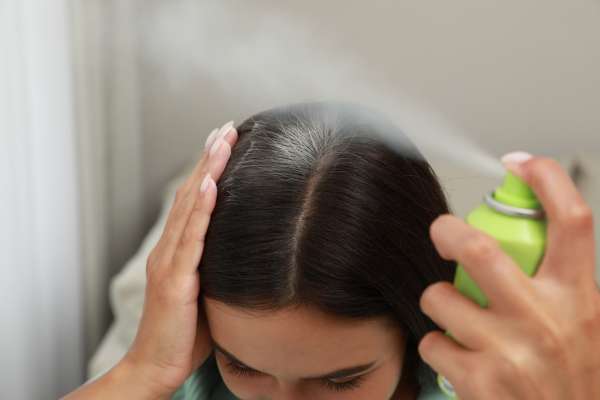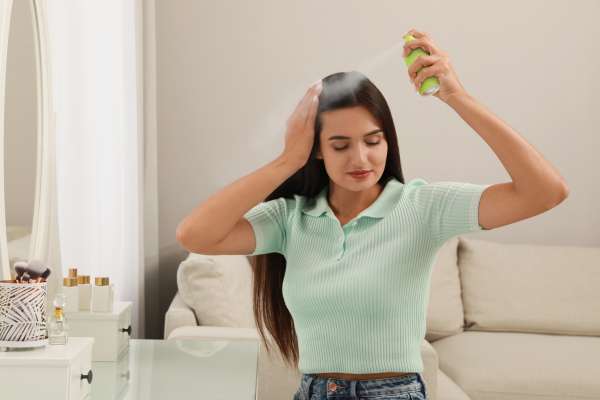Dry shampoo serves as a convenient alternative to traditional hair washing, offering a quick and efficient solution for refreshing hair between washes. This innovative product works by absorbing excess oil and dirt from the scalp and hairs, leaving it looking and feeling cleaner without the need for water. Ideal for busy lifestyles or moments when traditional washing is not feasible, dry shampoos not only saves time but also extends the life of hairstyles. So if you’ve ever wondered about the wonders of dry shampoo and how it can transform your mane, keep reading to discover all there is to know about this game-changing product.
Can Dry Shampoo Replace Regular Shampoo?
Dry shampoos has emerged as a staple in the hairs care routine of many, thanks to its convenience and effectiveness. However, the question arises: Can It replace regular shampoo? While It is excellent for absorbing excess oil, refreshing the hair, and extending the period between washes, it does not completely eliminate the need for traditional shampooing. Regular shampoo is essential for thoroughly cleansing the scalp and hair, removing dirt, sweat, and product build-up in a way that dry shampoos cannot. Therefore, while dry shampoos is a fantastic tool for maintaining hairs appearance and hygiene in-between washes, it should be used in conjunction with, rather than as a replacement for, regular shampooing.
How Dry Shampoo Works?
Understanding how dry shampoos works sheds light on its role in hair care. The primary mechanism involves the use of absorbent substances, such as starches or alcohol, which soak up the oil and sebum at the scalp when applied. This process not only helps to reduce the greasy appearance but also adds volume and texture to the hair, making it look freshly washed. The application is straightforward: the product is sprayed or sprinkled onto the roots of the hairs, massaged in to distribute it evenly, and then brushed out or blown dry to remove the excess powder. This method makes It a quick fix for reviving hair without water, particularly useful for those with busy schedules or in situations where traditional washing is not practical.
Benefits Of Dry Shampoo
1. Time Saves

One of the most significant advantages of dry shampoos is its ability to save time. In today’s fast-paced world, finding time for a full hairs wash and dry can be challenging. It provides a convenient shortcut, allowing individuals to refresh their hair without the need for water, shampoo, and conditioner, followed by the time-consuming drying and styling process. It’s as simple as applying the product to the roots, massaging it through, and brushing it out. This process can take just a few minutes, making dry shampoos an ideal solution for busy mornings, post-workout refreshes, or quick touch-ups before an unexpected meeting or event.
2. Extends Hairstyles

Another key benefit of Use dry shampoo is its ability to extend the life of hairstyles. After spending time and effort on styling hairs, it can be disheartening to see a look fall flat or become greasy within a day or two. Dry shampoos absorb the oil that can weigh hairs down, reviving volume and texture. This means that blowouts, curls, or any styled look can maintain their shape and freshness for longer periods without a complete wash and restyle. For those who want to avoid frequent heat styling or wish to maintain their hair’s appearance for special occasions over several days, dry shampoos are an invaluable tool.
3. Adds Volume and Texture

Dry shampoo is particularly beneficial for those looking to boost their hair’s body and texture. The product’s formula is designed to absorb oil at the roots, which can otherwise weigh hair down, causing it to look flat and lifeless. By applying dry shampoos, the hair gets an instant lift, as the powder particles create separation between hair strands, enhancing volume and making the hair appear fuller. Furthermore, it provides a matte texture that can help in styling, making it easier to achieve and hold hairstyles that require grip, such as updos or braids. This makes dry shampoos a favorite tool for not only refreshing hair but also for pre-styling preparation, offering a practical solution for fine or limp hairs seeking a volume boost.
4. Reduces Hair Damage

Frequent washing and styling can subject hairs to a lot of stress, leading to damage over time. Water can strip hair of its natural oils, leading to dryness, while heat styling can cause breakage and split ends. By incorporating It into your hair care routine, you can extend the intervals between washes, thereby reducing the hair’s exposure to water and heat. This can help to preserve the hair’s natural moisture balance and minimize thermal damage. Additionally, by lessening the need for daily heat styling, Shampoos can be a significant ally in maintaining healthier, stronger hairs. It’s an effective strategy for those looking to minimize damage without compromising on hair cleanliness and style.
How To Use Dry Shampoo Correctly
Using dry shampoos correctly is essential for maximizing its benefits while avoiding potential drawbacks. Start by shaking the bottle well to ensure the product is evenly mixed. Hold the can several inches away from your head and spray or sprinkle the It directly onto the roots, focusing on areas that tend to get oily. Use your fingertips to massage the product into your scalp, as this helps to distribute it evenly and absorb oil more effectively. Allow the dry shampoos to sit for a few minutes to fully absorb the oils. Then, use a brush or your fingers to remove any excess product and style as usual. For best results, apply it sparingly and avoid using it on consecutive days to prevent buildup. By following these steps, you can refresh your hairs, add volume, and extend your hairstyle with minimal effort.
Common Misconceptions About Dry Shampoo

Common misconceptions about dry shampoos often lead to misuse and disappointment with the product. A widespread belief is that it can serve as a complete substitute for regular shampoo Which is not the case. It is designed for temporary oil absorption and freshness between washes, not for removing dirt or build-up from the scalp. Another myth is that all dry shampoos work. The same for everyone, ignoring the fact that hair type, color, and individual needs greatly influence effectiveness. There’s also a misconception that It promotes hair health. While it can reduce damage from over-washing and styling, overuse without proper scalp care can lead to buildup and irritation. Understanding these misconceptions is crucial for incorporating It into a balanced hairstyle care routine effectively.
Choosing The Right Dry Shampoo

Choosing the right Shampoo requires consideration of your hair type, color, and personal preferences. For those with darker hairstyles, opting for a tinted formula can prevent the white residue that traditional It might leave behind. Individuals with fine or oily hair might benefit from volumizing or extra oil-absorbing formulas, respectively, to address their specific concerns. It’s also important to look at the ingredients list, especially if you have sensitive skin or are looking to avoid certain chemicals. Natural and organic options are available for those seeking gentler alternatives. Sampling different brands and types can help you find the It that best suits your needs. Ensuring you get the desired refreshment without compromising hair health or appearance.
Can Dry Shampoo Cause Hair Damage?
Dry shampoo can be a double-edged sword when it comes to hairstyle health. While it offers numerous benefits, including reducing the need for frequent washing and heat styling. There are circumstances under which it might contribute to hair damage. Overuse of shampoo can lead to buildup on the scalp and hair, potentially clogging hairstyle follicles and irritating the scalp. This buildup can make the hairstyle feel heavier, look dull, and in some cases, may even contribute to hair thinning if the scalp’s health is compromised. Additionally, some dry shampoos contain harsh chemicals that can dry out the hairstyle and scalp with excessive use. It’s crucial to use It in moderation, ensure thorough cleansing during regular washes. And choose products that are suited to your hairstyle and scalp type to mitigate potential damage.
Are There Natural Alternatives To Dry Shampoo?
For those concerned with the ingredients in conventional It or looking for more environmentally friendly options, there are natural alternatives. Ingredients like arrowroot powder, cornstarch, and baking soda can absorb excess oil without the use of aerosols or synthetic chemicals. These can be applied with a makeup brush or shaker to the roots of the hair and brushed through. Essential oils can be added for a pleasant scent and additional scalp benefits. However, as with any product, natural alternatives should be used judiciously to avoid buildup and ensure the scalp remains healthy.
Conclusion
Dry shampoo is a versatile product that can save time, extend hairstyles, add volume and texture, and reduce hairstyle damage caused by frequent washing and styling. However, it’s important to be aware of its limitations and the potential for scalp and hairstyle issues with overuse. By choosing the right product, whether conventional or a natural alternative, and using it as part of a balanced hairstyle care routine. It can be a beneficial addition to maintaining healthy, stylish hair without the downsides. Moderation is key, along with paying attention to the needs of your hairstyle and scalp. To fully enjoy the advantages It offers without risking damage.


